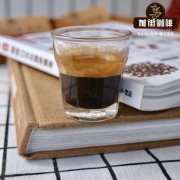How to roast espresso coffee beans espresso coffee beans brand recommendations_Italian coffee beans

Professional coffee knowledge exchange more coffee bean information please follow the coffee workshop (Wechat official account cafe_style)
How to decide which baking degree to use for espresso? How shallow and deep can espresso coffee beans be roasted and still have good espresso performance? And how do you use these different baking styles to add features to your espresso coffee bean retail business? Please take a look.
Start with mixed beans.
When we talk about baking beans for espresso, we are actually talking about the science of mixed beans. The highest sweet spots of all kinds of coffee beans from different countries appear at different baking points, so bakers must find a balance between baking and mixing beans in order to make a good cup of espresso. This knowledge begins with the degree of baking and the selection of beans, as well as the baking master's own taste acuteness. If you give full play to these three key points, you will have a good chance to produce espresso with a balanced export feel and a pleasant flavor. Of course, there are many subjective taste views, but based on my personal experience over the years, I can give you some suggestions.
When using Northern Italian baking, the bean selection process is the key point. You have to select the coffee beans with the lowest acidity at this baking degree. In my own Northern Italian formula, I use the least sour Brazilian beans out of 10 Brazilian beans. But if I go deeper, if I want to bake the Italian formula, I probably don't need to think about the acidity. About 50% of the Brazilian beans can meet this demand. If you want to use the deepest southern Italian baking, then every Brazilian can. Generally speaking, the Northern Italian formula must use mild flavor, low acidity arabica beans, the most classic formula is Mocha-Java, combined with Yemeni mocha and Java arabica beans, but there is another popular and widely used alternative formula is Ethiopia Harar plus Sumatra Mandheling.
The choice of beans in Chinese and Italian formula is more flexible, but you may have to choose several beans with a strong style, such as Ethiopia Harar. Many beans with high acidity, such as Costa Rica and Kenya, reach their peak when baked in Chinese and Italian style.
Southern Italian baking is too deep, so you have to use a very strong recipe, usually rough and strong African beans are very suitable for this way, such as Burundi or Harar. Personally, I think that when you enter the baking degree as deep as French Roast, you have a wide range of flexibility in choosing beans, because at this time, most of the qualities of coffee beans are baked off.
North Italian baking
In the case of relatively shallow baking (popular around Milan), this recipe produces a cup of espresso that tastes like sugar water. Personally, I think this kind of formula is the best combination of sweetness and baked drupe flavor, but it is the most likely to cause problems in the extraction stage. The Northern Italian formula has the greatest potential to produce sweet espresso, but it is very easy to screw up during extraction. The thick and sweet dry aroma means that the flavor at this time is the most complex and fragile, and the carbonization is relatively low. After years of practical experience, I have found that the North Italian formula, its aromatic substances after the action of hot water, is the most fragile, if the extraction is not handled properly, it will produce a "Jackyl and Hyde change", which is supposed to show a sweet smell of espresso, which may become too sour / bitter or astringent.
As a baking retailer, when you use most of these more fragile recipes, you will face the challenge of insufficient stability in the cup when brewing. Due to the lack of baking flavor substrate in the Northern Italian formula, if your bar staff is a little careless, the espresso will be easy to detect defects, especially when mixed with milk; when extracted by experts, when mixed with milk, it will highlight the strong caramel flavor in the espresso. To me, this caramel flavor is the style and characteristics of the Northern Italian formula.
Because the coffee beans of Northern Italian formula are less carbonated, they account for a high proportion of caramel flavor and regional flavor characteristics. It is a great challenge to retain these rich characteristics during cooking, especially in the stability of cooking water temperature. If the cooking water temperature changes too much (up and down more than four degrees Fahrenheit), caramel flavor will be the first to be sacrificed. Then there was a dull yellowish crema outflow. If the cooking water temperature is stable (the up and down change is less than 2 degrees Fahrenheit), the crema will show ochre red. But the ochre red crema does not mean that the caramel flavor can survive after brewing, even at a very stable temperature, it is often sour espresso, then the water temperature may be low (at sea level, the ideal cooking water temperature is 204 degrees Fahrenheit, the measuring point is near the coffee cake). On the thermostat in my store, I found that the sweeter the espresso, the easier it is for their crema to fall apart.
The Northern Italian recipe has many other challenges for professional brewers. For example, the machine must be cleaned very carefully, because the beans of the Northern Italian formula are particularly easy to absorb the smell from the coffee machine, and if the machine is not cleaned properly, the espresso will be uncomfortably bitter, between charred toast and smelly socks after exercise. In addition, it must be stored in the shape of the whole bean and flipped and mixed from time to time. Coffee beans are stored like red wine in a sealed and opaque container at a temperature of about 55 degrees Fahrenheit. In the case of pure arabica beans, beans must be used within 3-10 days after baking, when the crema status of espresso is the most complete. If a high proportion of robusta is used in the formula, the peak of crema may be prolonged, but it must be noted that although robusta beans can provide very thick crema, it is not helpful for sweetness at all. Under the northern Italian baking degree, the vast majority of robusta beans show astringent or woody taste, while good arabica beans show sweet taste.
The bar staff must be very skilled in order to correctly cook the North Italian formula. If there is any error in cooking or filling, resulting in the "channel" effect, the water flows quickly through this crack, the sweet molecules are destroyed, and the composition of the whole aromatic compound flowing into the cup is out of balance. Finally, the whole cup of espresso is occupied by astringency. In addition, the bar staff must also be careful not to put the espresso for too long. The cooked espresso must be mixed with milk as soon as possible. When making cappuccino, the sweet molecule of espresso is one of the important ingredients to form foam, but this ingredient will soon fade, and ceramic cups must also be preheated to preserve the espresso structure.
One of the keys to getting this seductive sweetness is the flow rate. To deal with this variable, the bar player must first carefully adjust the grinding scale. If the flow rate is too fast, it will be sour and astringent, and if the flow rate is too slow, it will be scorched and bitter. The goal of our store is to extract for 25 seconds, and the state of flow must be like a "mouse tail".
It may take years to cook a cup of Northern Italian espresso, but if you end up in a neighborhood where more customers like the taste, your business may be much better than other ripe bean retailers in the same community. However, if your goal is to open any type of chain store, do not choose this kind of northern Italian baking, practice cooking and try to fail a lot of times, you might as well choose a deeper baking formula, customers are more acceptable. The Northern Italian recipe is more suitable for baking retailers who aspire to the craftsman level to sell. A coffee lover with talent and great enthusiasm for coffee will be fascinated by the successful espresso of this Northern Italian recipe. Once you have successfully mastered the main points of the Northern Italian recipe, then you are almost unrivalled in the industry.
Chinese and Italian baking
When we bake deeper and more sugar begins to be carbonized or burned, this is called Italian baking, which is usually popular around Florence with this degree of espresso. This kind of formula produces slightly darker beans with a bitter flavor. But the baking degree is not deep enough to burn all the flavor characteristics of the production area, and the formula of Chinese and Italian style is mainly another type of balance, that is, the combination of bitterness, remaining sugar and flavor characteristics of the production area. There is more or less a hint of smoky aftertaste in Chinese-Italian espresso.
The Italian formula is extracted with an unstable boiling water temperature (most espresso machines on the market have a water temperature change of more than six degrees Fahrenheit). The espresso of the Italian formula still has a stable performance, so this type of formula is the most suitable for general baking retailers and, of course, for tall roasters to sell. The advantage of Chinese-Italian formula is that in case the bar staff is slightly negligent and the amount of espresso flows down exceeds the standard, the coffee of Chinese-Italian formula will still not have the defects of sour, thin texture, or astringency, and will only lack some sweetness compared with the beans of Northern Italian formula (even if the Chinese-Italian formula is carefully brewed, the sweetness will not be better than the carefully brewed Northern Italian formula espresso). In the Chinese-Italian formula, because the degree of carbonization is slightly higher, and the carbon itself is a chemically stable ingredient, it doesn't matter what stage of machine is used to brew this kind of formula, or it doesn't matter if you are not careful when making it. Anyway, there must be bitterness caused by carbonization in the cup.
The roasting depth of Italian coffee is getting deeper and deeper to the south for a reason. One hypothetical theory is that the amount of spices used by residents and their taste preferences are affected by different climates. Since ancient times, residents in the north have been convenient to preserve food and meat because of the lower average temperature. In contrast, the weather in the south is hotter, so residents have to rely on large amounts of spices to preserve their food. Many anthropologists believe that this has a certain impact on the taste preferences of residents in different regions, and may also explain why southerners prefer more intensive foods and drinks. The application of this theory to coffee explains why southerly coffee tastes more bitter. Of course, these are just theories, which can not be applied in a pluralistic society like the United States. However, if most of your customers belong to the southern ethnic group, you may find that they prefer the taste of deeper-roasted coffee.
Southern Italian baking
Southern Italian baking is the deepest baking stage in espresso beans. In this kind of espresso, bitterness / carbon taste is the main flavor, overshadowing most sweetness and regional flavor characteristics. Napoli in Nanyi represents the region, where you can find the deepest baked espresso in the world, leaving only a little sweetness and regional flavor characteristics. If you bake deeper, all that's left is probably carbon and bitterness. Because the bitter taste of espresso at this depth is very strong, it will cover most of the sweetness, but the flavor persistence at this time is the highest, which also increases the fault tolerance rate in cooking. With stylized training and machine, plus a professional bar trainer, this kind of espresso can be done. South Italian baked beans are very suitable for use in small espresso bar or small chain coffee shops. A cup of espresso with strong persistence can be made by using any business-grade machine.
When I visited Napoli, I personally tasted the espresso here. I saw that the bar hands there always kept the half-ounce espresso cups that had just been squeezed in hot water, and people on the Italian side would add a rub of sugar and stir it quickly and swallow it. I speculated that Southern Italian-baked espresso may have to be extracted (ristretto) in a very short time because there is less sugar in coffee beans, and it has been a tradition to squeeze fewer doses in order to balance the sugar and bitterness in the cup. Many people think that this baking method, coupled with this brewing method in Napoli, is the most perfect match in the world, but this combination may not be popular in the United States, because Americans prefer to drink large cups of coffee without bitterness!
Espresso coffee bean brand recommendation
The freshly roasted espresso coffee beans of Qianjie Coffee, a coffee roaster brand located in Dongshankou, Yuexiu District, Guangzhou, are fully guaranteed in brand and quality. And more importantly, the performance-to-price ratio is extremely high. Take the commercially recommended style of commercial blended coffee beans as an example, a pack of 454 grams, the price is only about 60 yuan. According to the calculation of 10 grams of powder for a single cup of espresso, a packet can make 45 cups of coffee, which costs less than 1.5 yuan per cup. Even if you use two heads per cup of espresso and 20 grams of powder per serving, the price of a cup of double espresso concentrate is no more than 3 yuan. Compared with the price of hundreds of yuan a pack sold by a well-known brand, it can be described as a conscience recommendation.
Qianjie coffee: Guangzhou bakery, the store is small but a variety of beans, you can find a variety of unknown beans, but also provide online store services. Https://shop104210103.taobao.com
Important Notice :
前街咖啡 FrontStreet Coffee has moved to new addredd:
FrontStreet Coffee Address: 315,Donghua East Road,GuangZhou
Tel:020 38364473
- Prev

Coffee beans suitable for Espresso recommend _ espresso coffee beans how to use _ espresso brand push
Professional coffee knowledge exchange more coffee bean information please pay attention to the coffee workshop (Wechat official account cafe_style) is more suitable for Espresso coffee beans espresso coffee beans rarely use a single bean, most are two or three (or more) beans mixed (Blending), each coffee shop will have its own recipe, it is not easy to explain
- Next

Why do Starbucks espresso beans roast deeply? how to choose espresso beans in a small shop
Professional coffee knowledge exchange more coffee bean information please follow the coffee workshop (Wechat official account cafe_style) the choice of large enterprises vs. The secret for small retailers to run a successful joint-venture grocery store is to provide products of stable quality, no matter which branch, the quality of the products they buy must be fixed. When it comes to coffee retail, this secret is also true.
Related
- Detailed explanation of Jadeite planting Land in Panamanian Jadeite Manor introduction to the grading system of Jadeite competitive bidding, Red bid, Green bid and Rose Summer
- Story of Coffee planting in Brenka region of Costa Rica Stonehenge Manor anaerobic heavy honey treatment of flavor mouth
- What's on the barrel of Blue Mountain Coffee beans?
- Can American coffee also pull flowers? How to use hot American style to pull out a good-looking pattern?
- Can you make a cold extract with coffee beans? What is the right proportion for cold-extracted coffee formula?
- Indonesian PWN Gold Mandrine Coffee Origin Features Flavor How to Chong? Mandolin coffee is American.
- A brief introduction to the flavor characteristics of Brazilian yellow bourbon coffee beans
- What is the effect of different water quality on the flavor of cold-extracted coffee? What kind of water is best for brewing coffee?
- Why do you think of Rose Summer whenever you mention Panamanian coffee?
- Introduction to the characteristics of authentic blue mountain coffee bean producing areas? What is the CIB Coffee Authority in Jamaica?

